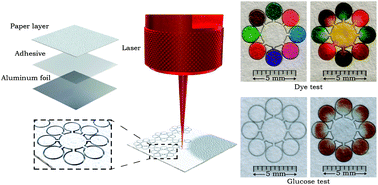Creating compact and microscale features in paper-based devices by laser cutting
Abstract
In this work we describe a fabrication method to create compact and microscale features in paper-based microfluidic devices using a CO2 laser cutting/engraving machine. Using this method we are able to produce the smallest features with the narrowest barriers yet reported for paper-based microfluidic devices. The method uses foil backed paper as the base material and yields inexpensive paper-based devices capable of using small fluid sample volumes and thus small reagent volumes, which is also suitable for mass production. The laser parameters (power and laser head speed) were adjusted to minimize the width of hydrophobic barriers and we were able to create barriers with a width of 39 ± 15 μm that were capable of preventing cross-barrier bleeding. We generated channels with a width of 128 ± 30 μm, which we found to be the physical limit for small features in the chromatography paper we used. We demonstrate how miniaturizing of paper-based microfluidic devices enables eight tests on a single bioassay device using only 2 μL of sample fluid volume.



 Please wait while we load your content...
Please wait while we load your content...